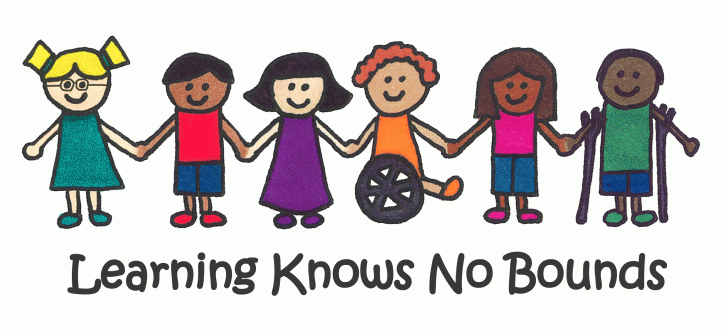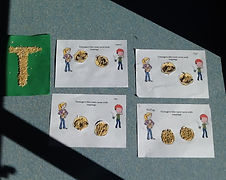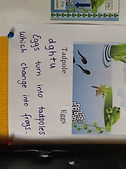

PROFESSIONAL TEACHING FRAMEWORK: FAEZA

Understanding curriculum documents, know content and how to teach it:
As I gain confidence, I have been designing curriculum documents with inquiry at the center.
The evidence based 5 E framework has been used to design science, PE & health and life skills
programs. Access and participation to these areas of curriculum is done through active
learning, experimentation, scientific process and journaling. Multi modal access to curriculum is
considered as is age appropriate resourcing. Academic rigour is maintained as students engage
in understanding the world around them.
As I teach a grade 3 to 5 Learning Support Unit, I am begining to develop a deep understanding of the Australian National Curriculum documents on the basis on which I develop scope and sequences and learning area specific programs. These processess allows me to align the curriculum outcomes to assessment and peadagogical strategies that best meet my students individual needs.
Around the classroom there are various student artefacts with explanation of how these artefacts link to the Australian curriculum. During learning journey seesions students share all their bookwork and arefacts with their parents, carers and school community. Using curriculum documents to align to teaching, learning, assessment and pedagogy and sharing these experiences allows for curriculum and school life to be percieved as meaningful and relevant.
Throughout my teaching degree, a comfortable familiarity has been built with the Australian Curriculum due to opportunities to create units and lesson plans for all key learning areas and apply these plans during professional placements. An effort has been made to actively engage students in understanding the key concepts and apply associated skills through various pedagogic strategies such as explicit teaching using concrete materials and every day language, inquiry based webquests, theme and 'big idea' based sensory learning experiences, consolidating mathematical concepts via art and engaging in higher order thinking by comparing and contrasting. In addition, understanding and application of specific literacy and numeracy stategies have been a core focus of the degree and professional placements. Care is taken to sequence learning experiences so as to build on prior knowledge, everyday language and experience before eventuating in abstact concepts and subject specific language. It has always been my intention to plan with the outcome and specific assessment in mind as this allows for the creation of learning experiences that keep student sucess in mind. I believe that sucess begets sucess and is a stepping stone to self motivation and independence. It has also been my focus to embed content and practice with numerous links to inclusivity and diversity, including Indigenous perspectives, which are a national cross curricular priority. I also believe that in this era when technological literacy is vital for individual sucess, it is essential to embed content and pedagogic knowledge with technological knowledge: the application of the most appropriate technologies to foster learning. I have thus increased my knowledge and skills in this area and created resources and a toolbelt which will allow me to engage students in sucessful learning experiences that intend to motivate them and foster a love of learning.






Inquiry based history lesson sequentially moving towards higher order thinking, comparing and creative diary writing.



Part of a history lesson comparing Australian history then and now, in relation to Indegenous Australians.
PROFESSIONAL KNOWLEDGE
As a preservice educator:
As a teacher:






Know the students and how they learn:
As a constructivist teacher I build concepts and skills using explicit, clear and everyday language, concrete materials and visuals before guided practice and independent work. Once students achieve fluency, these concepts and skills are generalised to different settings and maintained over the school year.
To ensure that students are actively engaged in their
learning, stimuluses that are of interest to students are
employed and linked to curriculum. We used the hatching chicks program as a stimulus to teach journal writing.
In my professional placement at a special needs school, I was working with students with multiple disabiltes and the main aim was to foster communication and independence. Under the guidance of my mentors, I familiaried myself with each of the ILPs and key learning area goals for each student. I also became familiar with the profile of each student which gave me insight into how to plan and implement lesson sequences that will lead to the outcomes of increased communication and mobility. Theme based 'big idea' learning was adopted where by the theme of growing was embedded with in all key learning areas. For guided reading a big book narrative on the story of a tadpole that changed into a frog was converted into PPT and shared daily- with sound effects, role play and enthusiastic acting to maximise meaning making. Students were moved transfered from their wheel chairs to their standing frames for the session as standing is vital for the optimum functioning of body organs. The concept of lifecyles of a frog were explored for science and for writing, students used aphabet aids and their core vocabulary of yes and no to write, with the assistance of a scribe, about the changes in a frog lifecycle. Gross motor session followed and students were transfered and assisted through a circuit that allowed for the three stages of the frog cycle to be role plaged allowing the student to practice their phsio excercises. Next the students had to move into their working chairs to a container of warm sago which simulated frog eggs for their sensory play session and for practicing writing the letter of the week. The sensory experience was continued with tasting and eating of sago custard. The letters R and T were learnt using art, craft materials that provided sensory learning experiences all within the theme of growing. Care was taken to include plenty of opportunites to grasp- pouring jug handle, gluestick, pva bottle, spoon. Grasping is the foundation skill of independence- which will later lead to grasping a fork, toothbrush, a handle to sit up and stand up. Every learning activity ensured that each student was treated with respect as it was assumed that their silence and difficulty with speech was not a reflection of their capacity to understand concepts or their ability to learn.










As a teacher:
As a preservice educator:

Program to meet individual needs and abilities:
To ensure that each students learning needs are met, it is important to diffrentiate the environment, content, support and resources. Students in my class take part in literacy and numeracy centers that are tailored to their level, yet provide enough of a challenge so as to maintain academic rigour.
During guided reading, some students work independently through various text types ranging from reports to procedures, while some students are provided with occasional LSA support and some are provided with intensive support by myself to ensure they understand and make meaning from various the texts. The environment is calm and quiet to reduce distraction, content is diffrentiated as some students ude readres while others use card texts, resources like coloured lines and laminated finger spaces are used by some. The aim is for them to gain effective meaning making skills and independence in reading over time.
One of my professional placements was in a main stream school in a middle school gifted and talented setting. The students in this class required a fast pace of learning as they were prone to getting bored, interesting content delivered through engaging pedagocic styles, student centered discovery based learning methods, content that was one to two years above the curriculum for that age group and challenging learning experiences. Given the needs and abilities of the cohort, I planned a science mini unit on the electro magnetic spectrum and delivered it through a web based setting. The intention was to discuss the core scientific concepts in class, then through a carefully planned and sequenced learning sessions, allow for students to inquire deeper into the concept, synthesise it, and create a document that would be loaded on to the web page. The project was based on questions that the students had to research and they progressed from LOT questions to HOT ones, so as to engage and challenge them. Students were free to decide if they wanted to work individually or with a peer. This project was assessed through criteria that were carefully explained in the rubric. Elements of digital citizenship and cyber safety were embedded within the unit. The web project and students work can be viewed by clicking on the picture or by going to the link below.
http://faezams.edublogs.org/6scg/
As a teacher:
As a pre-service educator:





Build knowledge through professional knowledge and development:
As a full time teacher, there have been many opportunities to further build professional knowledge and skills. In addition to attending courses and workshops that I have identifed as necessary to my current possition, I have also had acess to school based professional development opportunities and mandatory courses required by the Directorate of Education.
To date, the most applicable courses that I have been involved in are an online and face to face Autism Spectrum Disorders course, the Disability Standards Course, Adapt to learn- sensory awareness in the classroom as well as the New Educators Esssential skills and beyond courses. I take a couple of things from each of these courses and apply them to my current pedagogy. I collect data and then reflect on improvements made due to the application of these strategies. I also reflect of if something did not work and try and analyse it soa s to problem solve and adapy a differnt approach that may lead to sucess.
In addition, as part of our Professional Learning Community project, I am collaborating with five other teachers to do a case study on diffrentating to achive better outcomes for writing. We are currently conducting academic research and plan to implement our strategies soon allowing us to collect data for a few weeks and present our findings to the other educators.
During my six professional placements in various schools and settings and due to my work as a learning support assistant with the directorate for the last eight years, I have had numerous opportunities to increase my knowledge and skills through professional development courses and workshops. I have attended first aid training, specific anaphylaxis epipen workshops, work shops at the Autism unit in Yarralumla school, interactive white board training at Woden school, a Sue Larkey conference on Autism Spectrum Disorders, improving numeracy workshops: problem solving using the concrete resource 'Polly plugs', creating valid mathematics assessment resources, improving literacy workshops: using visualisation to aid comprehension, importance of building vocabulary and word conciousness, a Tony Attwood conference, the So Safe program on social safety, Teamteach: Positive Behaviour Management, OH&S courses and mandatory reporting. In addition to these workshops, I attended a forum of collaborative action research projects between University of Canberra and Crainleigh Special Needs School and gained insight into research questions, inquiry formats, data collection, data synthesis to inform evidence based practices that can improve student outcomes.
FIRST AID
EPI PEN
PROFESSIONAL DEVELOPMENT AS A PRESERVICE EDUCATOR
27 JUN
TONY ATTWOOD
CONFERENCE
6 MAY
TEAM TEACH: Positive Behaviour Support
IMPROVING LITERACY: Importance of word consciousness and building vocabulary
SUE LARKEY WORKSHOPS
TONY ATTWOOD CONFERENCE
IMPROVING LITERACY FORUMS
IMPROVING NUMERACY FORUMS
3 APR
As a pre- service educator:
As a teacher:
PROFESSIONAL DEVELOPMENT AS AN EDUCATOR
11 FEB
29 JAN
13 APR
16 MAY
ETD:
MANDATORY REPORTING, CODE OF CONDUCT, WORKPLACE BULLYING, WORKPLACE HEALTH AND SAFETY
ESSENTIAL SKILLS FOR TEACHERS & ESSENTIAL SKILLS AND BEYOND
AUTISM SPECTRUM DISORDERS
ADAPT TO LEARN- SENSORY AWARENESS

